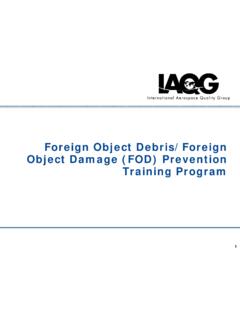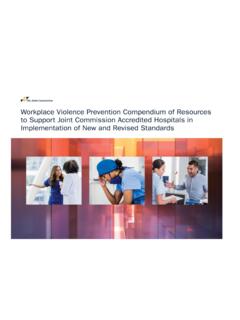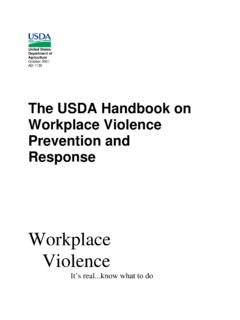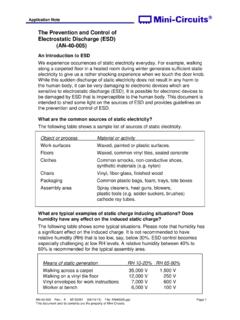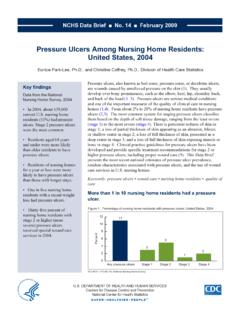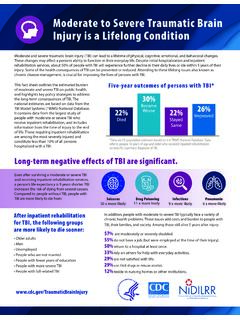Transcription of FOREIGN OBJECT DAMAGE (FOD) PREVENTION PLAN
1 FOREIGN OBJECT DAMAGE (FOD) PREVENTION PLANI nsert Specific Facility/Bldg Name or, if for general use, insert Company NameInsert Document Number ( , FOD-2014-001) to maintain a history of updatesTASKNAMEDATEP repared By:(to be filled in) FOD Program POC(to be filled in) Local Mgmt Approval:(to be filled in) EFFECTIVITY:Release Date: (Insert Date)(Location / Facility)Rev: ( New or next rev)INSTRUCTIONS : Replace all RED text with BLACK text. Remove this statement, and any non-applicable information as necessary. Completed FOD Plans should be reviewed/approved by local facility management and kept in a local document repository for of :.. Program Definitions / Acronyms / Terms.
2 Requirements:.. Documents:.. PREVENTION Training:.. Requirements:.. Requirements:.. :.. Clean As You Go :.. "6S":.. PREVENTION Area Identification:.. PREVENTION Area(s).. , Handling, Storage & Transportation (PHST):.. Attire and Personal Items:.. Food/Drink Reporting:.. Reporting Criteria:.. Incident Reports:.. Walk s / Walk Downs / Sweeps:.. Categories:.. Program Surveys:.. Retention Requirements:.. FOD PREVENTION Practices:.. (Test, Support, and/or Facility) & Tooling Accountability & Small Parts (MSP) and Consumables:.. Checklists:.. Program Points of Contact:.. & Product Sensitive Area PREVENTION Area Map/Floor Count :This document details the policies and practices necessary to ensure that (insert facility/bldg/company) supports the FOD-free fabrication, assembly, test and processing of all components and products. The plan may also outline unique FOD Program requirements requested by local management and/or the customer.
3 :This plan applies to (insert your building(s), facility (s) title, and/or location(s)) where Hardware and/or Vehicle(s) are fabricated, assembled, transported, stored and/or tested. (update wording to reflect your specific environment) Program Definitions / Acronyms / Terms:(Insert your own unique Definitions / Acronyms / Terms as required)FOD:(1) FOREIGN OBJECT substance, debris or article alien to a vehicle or system which would potentially cause DAMAGE .(2) FOREIGN OBJECT DAMAGE attributed to a FOREIGN OBJECT that can be expressed in physical or economic terms which may or may not degrade the product s required safety and/or performance Documents:The (insert company/facility name) FOD PREVENTION plan is designed to address the concerns outlined in the following documents as related to product/process integrity: NAS 412, FOREIGN OBJECT DAMAGE / FOREIGN OBJECT Debris (FOD) PREVENTION NASA-STD-6016, Standard Materials and Processes Requirements for Spacecraft ISO-9000/9001/AS-9100 Quality Management Standard (if applicable)(Add any customer or other regional documents that might apply) PREVENTION Training:All personnel with access to FOD Sensitive Products/Areas shall receive FOD PREVENTION training.
4 Local management is responsible for verifying that all employees working within affected areas/functions have completed the requisite training per company Requirements:Employees of (insert company/facility name) are required to complete the following training: New Employee FOD Awareness Course (insert training requirements here) Requirements:Visitors and other non-(insert company name) individuals, contractors, and government agency personnel may be escorted within FOD PREVENTION Areas in lieu of training. If visitors are not escorted, then they must receive a FOD program briefing or complete the employee training. The level of training required for visitors should be at the discretion of local :Utilize normal "Clean As You Go" and "6S" routines to provide an organized and professional working environment for personnel and hardware processing. FOD walks should be performed under the direction of local management when Clean As You Go :"Clean As You Go" is an aerospace industry standard routine for cleaning up work areas prior to, during and after work efforts.
5 It is the continuous practice of debris removal and surface cleanliness during manufacturing, maintenance or any operation involving sensitive hardware, equipment or tools. The routine prevents accumulation of FOD, and thus greatly decreases the potential for FOD mitgrating into or damaging hardware. The following are good clean-as-you-go practices, and should be applied on an everyday basis: Clean up the immediate and surrounding areas when work cannot continue. Clean up the area when work effort is complete. Clean up the area when departing for 15 minutes or longer. Clean up any generated debris that has the potential to migrate to an out of sight or inaccessible area. Clean up debris that has the potential to cause DAMAGE to hardware and/or would give the appearance of poor workmanship or housekeeping to a customer. Clean up the area before the next planned operation in support of an inspection point. Clean up the area prior to a work shift change or unplanned "6S":"6S" is a lean manufacturing technique that helps organize a work area to optimize efficiency.
6 Areas setup and maintained using the 6S guidelines are less likely to generate FOD that will become entrapped or result in product "6S" acronynm stands for: Sort: Separating needed materials/ from unneeded Straighten: Organizing everything in its place. Places should be identified/marked. Shine: Establishing general cleanliness and cleaning routines/schedules Standardize: Maintaining and monitoring the 1st three S s, and keeping consistency across areas Safety: Removing hazards and mistake proofing procedures Sustain: Embedding 6S into the culture, and instilling PREVENTION Area Identification:FOD PREVENTION Areas must be clearly identified by signage and/or boundary markers. If required, temporary FOD PREVENTION Areas can be established or existing FOD PREVENTION Area controls and/or levels (if applicable) may change given the approval of local management.(FOD Signs are available at at discounted rates)See Figure 1 for FOD PREVENTION Area signage and basic PREVENTION Area(s)The following areas within the site/facility are designated as FOD PREVENTION Areas:1.
7 (insert descriptions of area(s) to be controlled and each area s sensitivity level (if applicable), temporary areas need not be added to your FOD PREVENTION plan )See Figure 2 for (insert company/facility name) layout/floor , Handling, Storage & Transportation (PHST):Inadequate or improper packaging coupled with unclean movement containers or fixtures can allow the introduction of FOD into products during normal movement and inspection of an assembly through an area or between areas or sites. All FOD Sensitive Product movement containers or fixtures are to be cleaned in accordance with the applicable work instructions. FOD barriers such as product connector covers should be installed, as reasonable, on all open cavities during product moves. Products are to be adequately packaged and appropriate packing materials chosen to ensure that these materials do not migrate into recesses or cavities within the Attire and Personal Items:Proper working attire and control of personal items are essential to prevent the inadvertent invasion or DAMAGE to FOD sensitive products.
8 Personal items must be secured or removed to prevent them from becoming FOD. Food and drink should not be allowed within the work area unless it is limited to designated Food/Drink AreasThese areas must be clearly identified with signage and/or boundary markers. The consumption of food and drink items within the work area should be limited to this area, and items should be transported to this area in a sealed bag/container to limit potential contamination of hardware. Locations which utilize, store and/or dispense chemicals or hazardous materials should not be near a designated food/drink area. Local area management is responsible for identifying these areas and enforcing these Reporting:Incidents involving FOREIGN objects should be reported to local management and investigated to determine the root cause and appropriate corrective actions. The data collected from incident reports can help to identify systemic issues and trends, as well as establish a baseline for expected Reporting Criteria:An incident report is required when one or more of the following criteria are met:(Criteria below provided as an example customize to your local needs) DAMAGE to hardware or equipment is identified and confirmed to be caused by an unknown source of FOD.
9 FOD that is visible to the unaided eye is discovered in a FOD Sensitive Product after the operation in which it was introduced has been completed, during a time when one would expect the product to be FOD free. An OBJECT is lost, misplaced, or unaccounted for within a FOD Sensitive Product or Area, and is not located and removed before the task and any task-related close-out inspections are completed. An open hole or vacant position is discovered within a FOD Sensitive Product where an item is normally mounted, attached, or applied. An OBJECT is found within a shipping or storage container that is FOREIGN to the package contents or packaging : If FOD is introduced, discovered, and removed before the operation in which it was introduced is completed, it is not considered an Incident Reports:(Criteria below provided as an example customize to your local needs)An initial incident report should be issued no later than 48 hours after the intial discovery of an incident.
10 The intial report does not require cause and corrective action information, but should inform the appropriate parties that an incident has location at which the incident was discovered should assign the task of determining root cause and corrective actions to the area(s) they believe are responsible (may assign to themselves). The assignee should then conduct the investigation and report back their initial findings within 2 weeks. If additional time is necessary to close the investigation, it should be coordinated with the management of the finding location. The information from the incident report should be entered into the Organizational FOD Database within 1 month so that metrics can be Walk s / Walk Downs / Sweeps:A walk down is an informal activity where local personnel physically walk through a FOD PREVENTION Area (often side-by-side or shoulder-to-shoulder) to inspect the area cleanliness and remove loose or unwanted items. Items are then recorded (type & amount) for use in local area metrics and disposed of per area practice.

